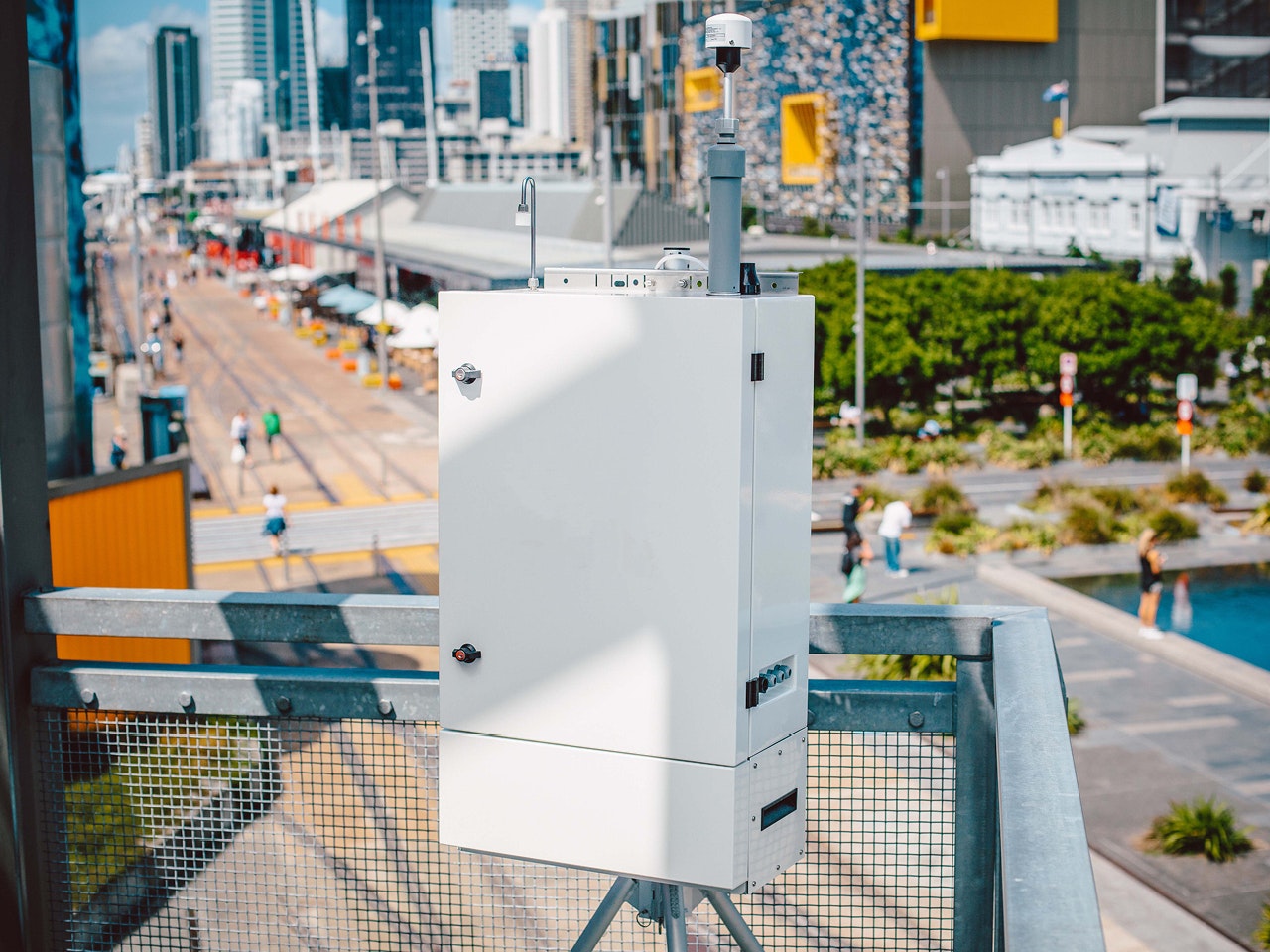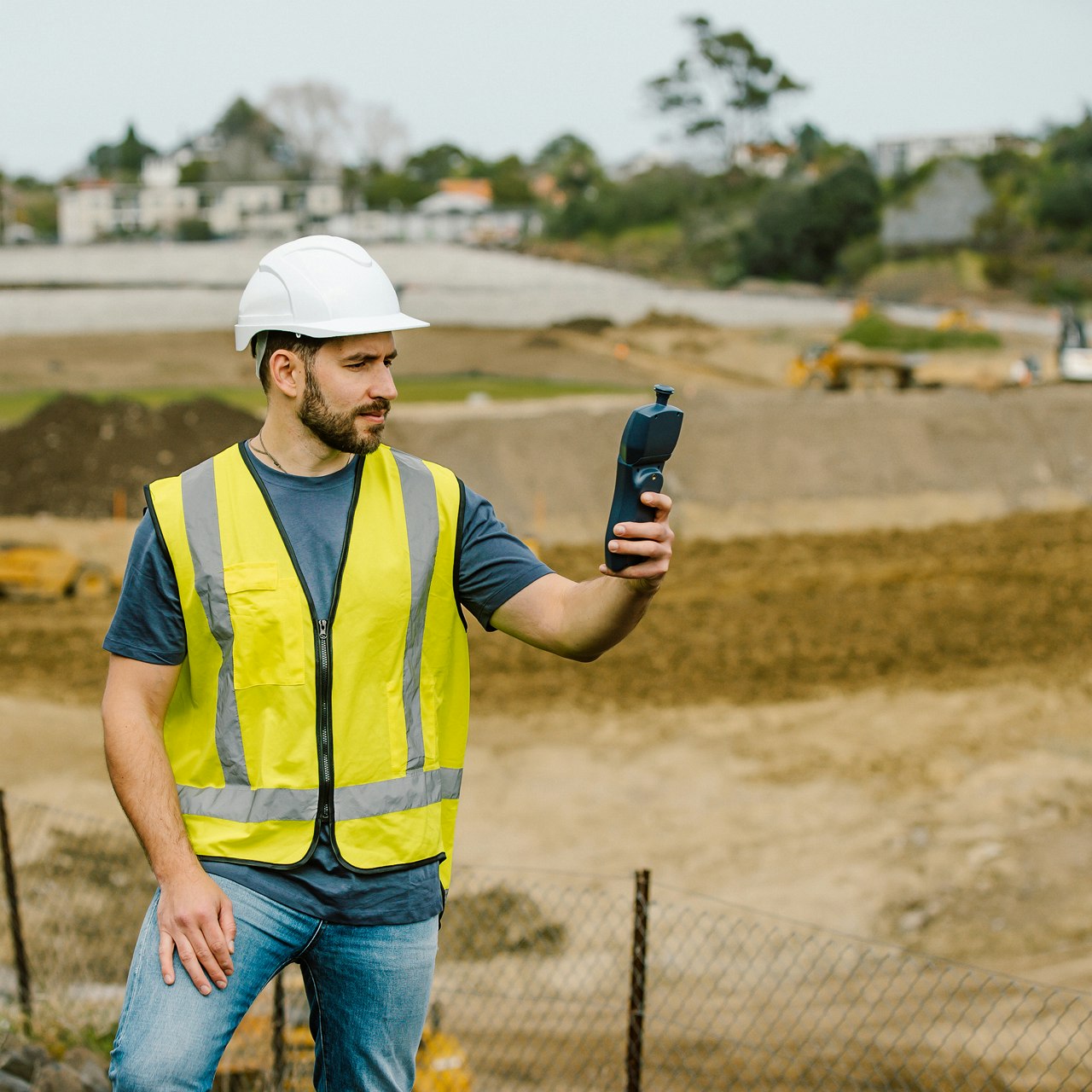Measurements
Nitrogen Dioxide NO2
Aeroqual designs and delivers monitors that measure nitrogen dioxide (NO2). Choose from our perimeter or handheld air monitoring range.
Here we cover NO2 measurement principles, specifications and performance.
Overview of nitrogen dioxide
Nitrogen dioxide (NO2) is one of six criteria air pollutants identified by the United States Environmental Protection Agency (US EPA) and is monitored extensively around the world by regulatory agencies.
NO2 can be emitted directly from industrial process and combustion. NO2 can also be formed as a secondary pollutant by reaction of nitric oxide (NO) and ozone (O3). To learn more about NOx, NO and NO2, read our blog on A Beginner's Guide to the Nitrogen Oxide Family as Air Pollutants.
Perimeter air quality monitors
The NO2 analyzer module features in our perimeter air quality monitors: AQS 1 Air Quality Monitor and AQM 65 Monitoring Station.
Module measurement principle
The nitrogen dioxide module used in Aeroqual’s range of fixed monitors uses a cutting-edge automatic baseline correction (ABC) design to measure nitrogen dioxide (NO2) in ambient air. It combines an advanced electrochemical NO2 sensor with an integrated O3 filter and a sample/zero cycling operation to deliver near reference performance in ambient NO2 monitoring.
The sensor used in the NO2 module is an electrochemical gas sensor. The sensor generates an electrical current in nA which is proportional to the concentration of gas that comes in to contact with the sensor.
The module uses a patented design that creates two different flow paths, one of which passes through a proprietary scrubber to remove NO2 and produce a baseline measurement. The module has a controlled flow rate across the sensor. The flow rate is determined by a flow control orifice on the exhaust side of the sensor and measured at the inlet to the sensor module (expected to be approximately 60 mL min-1).
The sensor current is measured during both the baseline and sample measurement states and these values are used to calculate the NO2 concentration using a proprietary algorithm approximately once per minute.
Module specifications and performance
The NO2 module performance specifications are given in the table below.
NO2 Analyzer Module
Range (ppb)
0 - 500
Display Resolution (ppb)
0.1
Noise: Zero (ppb); Span (% of reading)
<1; 1%
Limit of Detection (ppb)
<1
Precision
2% of reading or 2 ppb
Linearity (% of FS)
1.5%
24 hr Drift: Zero (ppb); Span (% of FS)
1; 0.2%
Field test results
An Aeroqual AQM 65 containing an NO2 module was co-located in April 2022 at an air quality regulatory station in Riverside, Southern California and its data compared with the reference data downloaded from the US EPA AirNow website. The NO2 module produced an R2 of 0.96 and a mean absolute error (MAE) of 1.3 ppb. The low MAE value is indicative that the module has low zero and span drift.
Nitrogen dioxide module time series plot
Nitrogen dioxide module scatter plot of data with linear regression and coefficient of determination
Demonstration of equivalence
The total measurement uncertainty, based on the EU Guide to Demonstration of Equivalence, using an hourly limit value of 100 ppb, was calculated as 5.8%. Note that an expanded relative uncertainty of less than 15% is required for an NO2 monitor to be considered regulatory grade (Directive 2008/50/EC). The NO2 module meets this requirement.
Directive 2008/50/EC downloaded 10/02/2023 here.
Module calibration and traceability
Just like a regulatory nitrogen dioxide analyzer based on chemiluminescence, this sensor-based system can be fully field calibrated using standard calibration equipment and reference gases. This ensures the module calibration is fully traceable to NIST primary standards.
The NO2 module factory calibration is achieved using a zero-air source, certified calibration gas standards and a certified gas dilution calibrator. The Aeroqual AirCal 1000 or 8000 systems can be used to calibrate the NO2 module in the field.
Calibration frequency will be dependent on the user’s data quality objectives and Quality Assurance Project Plan (QAPP), but based on the low rate of field drift the recommended calibration frequency is 1-3 months.
Aeroqual also offers its patented remote calibration procedure, MOMA, for this module, which avoids the need for a site visit while also maintaining traceability to nearby regulatory air monitoring stations. See your Aeroqual representative for more information on this software tool.
Interferences
The Aeroqual NO2 module is specific towards NO2 but other gases in the environment may also cause a response from the NO2 sensor. These do not indicate a fault. These effects are part of the module behavior and should be considered when examining data.
The NO2 module response to other ambient air pollutants is documented in the table below.
Pollutant
Test concentration / ppm
Typical module response / ppm
O3
0.1
0.001
CO
1.0
-0.005
SO2
0.1
-0.003
H2S
0.1
-0.020
Ethylene
0.5
0.005
Module expected lifetime
The non-catalytic chemical scrubber has an expected life of 2 to 3 years. The internal solenoid has an expected life of 2 to 3 years. The GSE sensor has an expected life of 2 years in climates with moderate humidity. In climates with very high humidity the expected life may be reduced.
Handheld air monitors and fixed indoor monitors
The NO2 sensor head features in our handheld air quality monitors: Ranger, Series 500, and fixed indoor Series 900 air monitors.
Sensor head measurement principle
The Aeroqual NO2 sensor head uses a gas sensitive electrochemical (GSE) sensor, with an inbuilt ozone scrubber. GSE NO2 sensors are often susceptible to ozone cross-interferences. By using a NO2 sensor with a selective ozone filter, we can get a direct measurement of NO2 without interference from ozone. The electrochemical gas sensor in the sensor head generates an electrical current in nA, which is proportional to the concentration of gas that comes in contact with the sensor. The sensor current is converted into NO2 concentration.
Sensor head specifications
The NO2 sensor head specifications are given in the table below.
Sensor code
END
Sensor type
GSE
Range (ppm)
0-1
Detection limit (ppm)
0.005
Accuracy of factory calibration
<±0.02 ppm 0-0.2 ppm
<±10% 0.2-1 ppm
Display resolution (ppm)
0.001
Response time
30 seconds
Sensor head cross sensitivities
Although the GSE sensor in the nitrogen dioxide sensor head is designed to measure NO2, it does show cross-interferences to other gases. The table below shows the response in ppm of the NO2 sensor head to different gases.
Gas
Nitrogen dioxide (NO2) (SH END)
O3 1 ppm
-
CO 25 ppm
<-0.75
NO2 1 ppm
-
SO2 1 ppm
<-0.03
H2S 1 ppm
<-0.8
Ethylene 5 ppm
<0.05
CO2 400 ppm
<0.4
H2 1 ppm
<0.001
NO 5 ppm
<0.25
Sensor head field results
An Aeroqual S500 with a nitrogen dioxide sensor head was co-located for 4 days with an Ecotech EC9841 NOx analyzer to demonstrate performance outside the Aeroqual office in Auckland, New Zealand. The time series and scatter plots are shown below. The sensor head gave an R2 value of 0.8, showing good correlation with the reference instrument.
Nitrogen dioxide sensor head time series plot
Nitrogen dioxide sensor head scatter plot
Products that measure nitrogen dioxide
The following products measure nitrogen dioxide, as well as particulate matter and gaseous pollutants in real-time.
Articles
Case Study - Brownfield Redevelopment
Devil's Gate Reservoir Restoration Project
Blog - Remediation
Perimeter Air Monitoring Plan Requirements – What All Site Remediators Need to Know
Blog - Remediation
Producing Defensible Data: The Importance of Keeping Calibration Certificates Up to Date
Inquire about our nitrogen dioxide products
Our NO2 advanced monitoring systems deliver hyper-local data and real-time alerts, giving you actionable data to make the decisions that matter.












